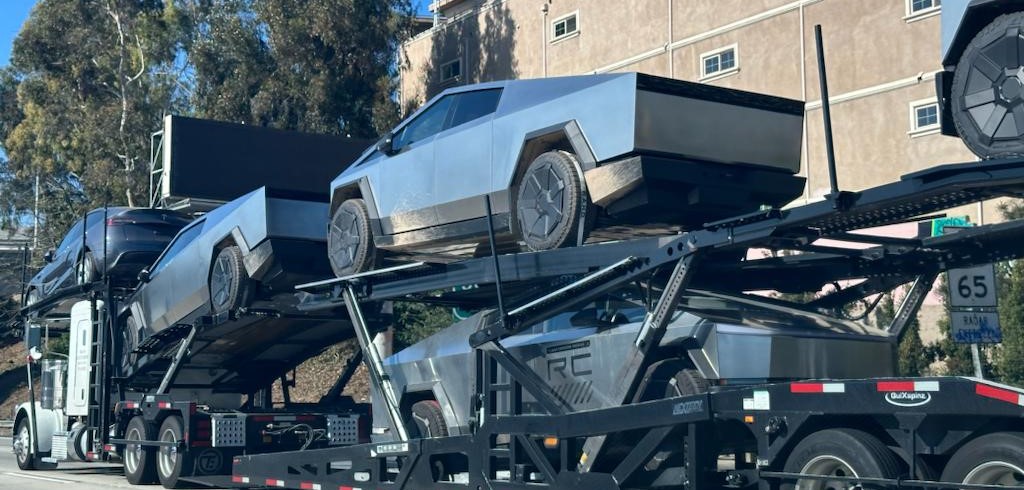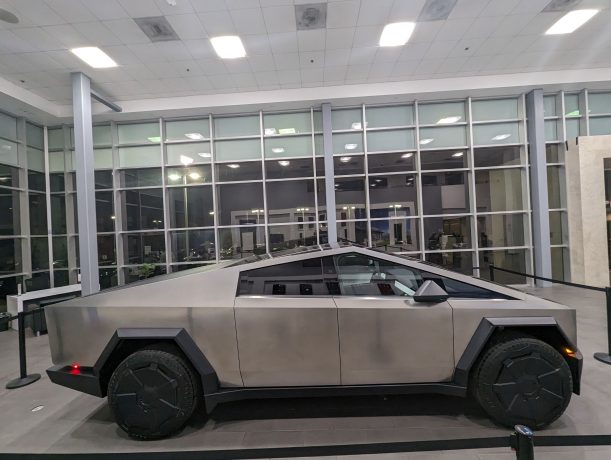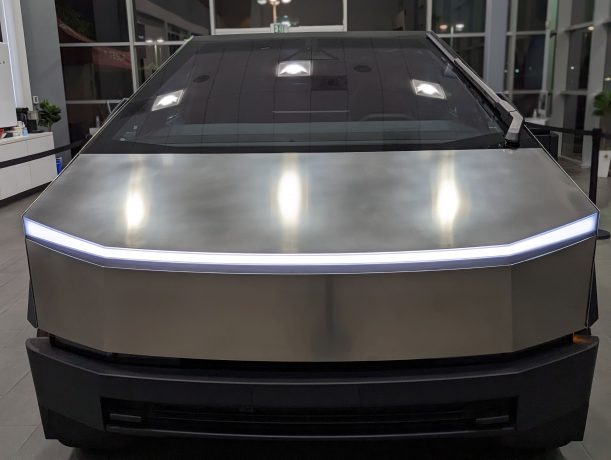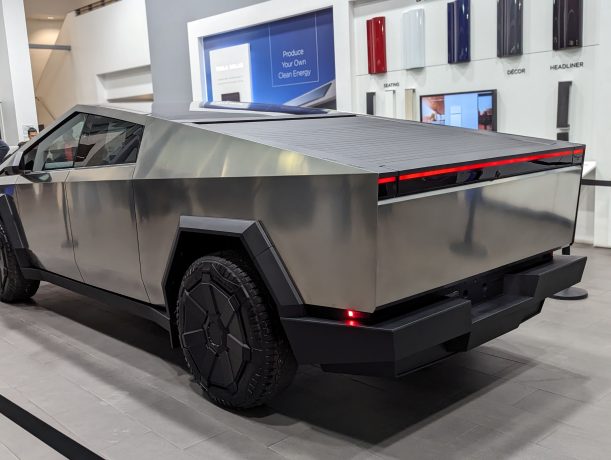
Discover how Tesla's Cybertruck offers not just a bold design, but also significant financial benefits for businesses, especially those utilizing S-Corp tax structures. Our article delves into its tax incentives, strategic advantages, and what this means for forward-thinking entrepreneurs.
by Zach Javdan
December 8, 2023
When it comes to electric pickups, Tesla’s long-teased Cybertruck has revved up a lot of chatter. Its recent customer deliveries and angular styling definitely turn heads. But beyond the hype lies some intriguing financial potential for business owners.
Tesla’s starting up deliveries with a fully loaded tri-motor Cyberbeast “Foundation Series” Cybertruck, clocking in at a lofty $119,900. The fully loaded dual-motor variation is also available for $99,900. It shows they aim to cater to early adopters first.
The Foundation Series, which costs an additional $20,000, includes the following:
(1) Limited-Edition Configuration; (2) Laser-Etched Foundation Series Badge; (3) Foundation Series Cabin Graphic; (4) 20” Cyber Wheels with 35” Tires; (5) White Décor; (6) Premium Accessories; (7) Powershare Home Backup; (8) Powershare Mobile Connector; (9) Full Self-Driving Capability; (10) Lifetime Premium Connectivity.
The Cyberbeast Founders Series variation also includes an off-road lightbar.
Wow, I’m currently getting a TON of DMs from followers saying that Tesla is inviting them to configure Foundation Series Cybertrucks. I’ve confirmed each one with screenshots, etc. NONE of them are Tesla employees. Exciting times! pic.twitter.com/B9IR6Fqny6
— Sawyer Merritt (@SawyerMerritt) December 9, 2023
The single motor variant is not currently available to purchase.
Combined with federal EV credits (for those who opt for the dual motor non-Foundation Series version at $79,990) and strategic tax planning under an S-Corp structure, California entrepreneurs could enjoy sizable deductions from integrating this “truck of the future” into their fleet.
Sure, most businesses need practical workhorses, not angular luxury statements. But for certain owners, the Cybertruck presents an opportunity to explore something new while optimizing their tax situation.
At the end of the day, trucks must serve key business functions. But Tesla’s Cybertuck does get points for opening up conversations around tech and taxes. Savvy owners may benefit if the stars align on their specific needs.

The Tesla Cybertruck, a blend of luxury and innovation, on display.
The Cybertruck – Beyond the Hype
Tesla’s futuristic pickup has sparked lots of chatter between its unusual styling and long production delays. But now that it’s finally rolling out to customers, the Cybertruck brings some serious capability – and potential tax optimizations.
With up to 500+ horsepower, adaptive air suspension, and nearly 18 inches of ground clearance, this electric truck aims to be an off-road beast. Yet features like bidirectional charging, power export, and integration with Tesla’s Virtual Power Plant also make it a grid asset.
Savvy S-Corp owners can stack federal EV credits on top of the tax advantages already baked into their structure. For those running operations where a secure, high-tech truck aligns with business needs, the Cybertruck presents some compelling incentives.
Sure, this angular EV won’t replace every gas-powered workhorse overnight. But beyond the hype, Tesla’s first pickup offers an intriguing mix of capability and potential savings for the right owners.
Balancing Innovation and Tax Strategy
Today’s entrepreneurs and business owners balance ambition with strategic planning. When evaluating new assets, they consider alignment with both values and long-term financial goals. In many ways, Tesla’s Cybertruck represents this new mindset.
Past its space-age styling, this electric pickup opens the door to some compelling tax incentives. From S-Corp benefits to federal credits, the right owner could offset costs while adopting innovative technology.
The Cybertruck will certainly grab attention on the roads and trails. But for operators who map out its tax-saving potential, it could also drive significant deductions behind the scenes. Function supporting form and vice versa.
In the following sections, we’ll break down the specifics around integrating Tesla’s new truck into different business structures and strategies. The future-focused entrepreneur knows that innovation and tax optimization can make perfect partners.
The Cybertruck – A Standout Symbol
With its triangular body, angular lines, and stainless steel finish, Tesla’s first pickup stands out from every other truck on the market. The Cybertruck seamlessly blends boundaries – it’s an SUV, sports car, and utility vehicle in one radical package.
From rocket-like acceleration to advanced Autopilot features, this electric truck pushes extremes while promising 200,000+ miles of near maintenance-free operation. Owners aren’t just preordering the latest model – they are buying into a radically different vision of the future.
The Cybertruck’s funky functionality challenges norms. For forward-thinking entrepreneurs, it represents the chance to align innovations with business strategy and sustainability. More than transportation, it’s an angular symbol of what’s possible.
Musk’s Unconventional Vision
The Cybertruck reflects CEO Elon Musk’s boundary-pushing vision. While Detroit sticks to the same old pickup formulas, Tesla delivers something radically different – just as Musk intended.
With the Cybertruck’s unconventional design, focus sustainability, and promise of shattering performance benchmarks, it encapsulates Musk’s ethos of driving innovation through unconventional thinking.
Years since its announcement, the Cybertruck finally brings to life the initial sci-fi inspiration. More than any other Tesla vehicle, this angular pickup trucks cements Musk’s vision for a radically different energy and transport future.

Close-up of the Cybertruck’s innovative design in the showroom.
Eco-Friendly Functionality
While the Cybertruck certainly stands out, its underlying eco-friendly capabilities help power that vision. As the first Tesla pickup truck, it aims to blaze trails as a more sustainable workhorse option.
Touting a targeted EPA range of 300+ miles in some trims, and the option of adding on a range extender (installed into the bed) which increases the range to 400+ miles, the angular EV promises to deliver reliability and efficiency for business use cases ranging from construction to outdoor adventure.
For eco-conscious business owners, the Cybertruck’s funky green towing power aligns with corporate values around sustainability. Form and function combined to drive real eco-impact at scale.
The S-Corp Advantage
Savvy business owners are increasingly exploring the S-Corporation structure for its tax advantages. Unlike traditional C-Corps, S-Corps allow income, losses, deductions and more to “pass-through” without double taxation.
While the details can get complex, the concept is straightforward – S-Corp owners can use the structure’s inherent benefits to optimize their tax picture. All while still providing limited liability protections.
With states like California also offering incentives, the S-Corp presents a compelling framework to integrate strategic assets like Tesla’s Cybertruck tax-efficiently. More than just savings, it enables entrepreneurs to take risks, innovate faster and reinvest more.
Maximizing Savings Through S-Corporation Tax Planning
Forming an S-Corporation framework unlocks highly strategic tax planning options to maximize business profits. Unlike sole proprietorships, partnerships, or C-Corps, the unique S-Corp structure leads to major tax advantages:
Eliminating Double Taxation of Earnings: S-Corps use pass-through taxation so all earnings avoid taxation at the corporate rate. Profits & losses instead pass directly to owners’ personal tax returns. This saves significant money by eliminating double hits on dividends. C-Corps cannot provide this benefit.
Balancing Salary & Dividend Sources: Paying a portion of earnings as tax-free dividends, while taking the rest as reasonable salary preserves S-Corp status rules but creates major tax optimization flexibility versus taking 100% ordinary wage income.
Avoiding 15.3% Self-Employment Payroll Taxes: Unlike traditional sole proprietorships where 100% of net business income gets assessed these taxes for Social Security and Medicare, dividends paid out to S-Corp owner-employees completely bypass this >15% levy.
Stacking California Business Incentives: In addition to the inherent S-Corp tax benefits, California offers numerous business tax credits for expenses like R&D or renewable energy investments. S-Corps in CA can stack these credits on existing federal deductions.
Supporting High-Growth Businesses
The innate tax efficiencies of an S-Corp structure uniquely benefit high-earning business models poised for rapid growth. With more cash preserved from tax savings, these companies reinvest in additional R&D, talent acquisition, and capacity expansion.
Specifically for well-compensated business owners and entrepreneurs, the advantages are multiplied further. The S-Corp allows them to take risks, innovate faster, and leverage strategic personal assets while retaining 8-figure income potential.
In essence, stacked S-Corp incentives give rapidly scaling businesses extra fuel to reach escape velocity. Combining tax optimization with liability protections unlocks exponential progress potential.
Optimizing Total Cost of Ownership
Now in initial low-volume production, updated Cybertruck pricing spans from $60,990 for the single motor RWD model up to $99,990+ for the ultra high-performance tri-motor “Cyber Beast” range-topper.
Dual motor AWD variants scheduled for 2024 start at $79,990. Tesla is prioritizing top-tier trims for earliest production.
The disappeared sub $40,000 workhorse version shows chasing volume isn’t the priority. The Cybertruck is an armored status symbol first, offsetting costs secondarily.
Federal EV Tax Credits: Cybertruck trims may qualify for up to $7,500 in federal EV tax credits under latest IRS guidelines. If qualified, the credits would directly reduce eligible owners’ tax obligations, effectively partially offsetting purchase prices. S-Corp owners can use the credits to partially offset acquisition costs. C-Corps benefit by reducing net tax liabilities.
Section 179 First-Year Deductions: The tax code allows deducting the full purchase price of qualifying vehicles and equipment. With a $1,080,000 maximum deduction this year, the entire MSRP of almost all Cybertruck versions can qualify.
Combined with S-Corp benefits, Section 179 unlocks substantial first-year optimizations for eligible owners.
Accelerated Bonus Depreciation: Businesses can deduct 100% of asset values in excess of the Section 179 cap via bonus depreciation allowances after maxing out 179. This further minimizes tax obligations.

Envisioning the Cybertruck’s role in modern business settings.
Analyzing Total Cost Efficiency by Trim
Single Motor RWD Cybertruck
Acquiring the $60,990+ single motor RWD model within an S-Corp framework reveals multiple avenues to substantially minimize total expenses:
– Full Section 179 deduction valued at $17,077 in immediate tax obligation relief (at hypothetical 28% rate)
– Additional $7,500 in Federal EV Credits directly reduces dollar-for-dollar taxes otherwise due
– Carrying forward remaining basis then triggers 100% First Year Bonus Depreciation, shielding future income
With deductions actively stacked, eligible owners can engineer scenarios where lifetime tax outlay is just a fraction of the starting MSRP – drastically slashing true total cost.
Dual Motor AWD Cybertruck
Stepping up to the $79,990+ Dual Motor trim reveals supplementary paths to efficiency:
– $1,080,000 Section 179 ceiling enables complete first-year write-off – equating to $22,397 tax savings at 28% rates
– Stackable $7,500 Federal Credit brings additional gross tax relief
– Carrying over residual basis then triggers Bonus Depreciation, shielding high levels of income from taxation in future years
Where eligible, savvy owners can leverage layered tax code incentives to legally minimize total obligations over time to a fraction of the starting MSRP.
Tri-Motor “Cyber Beast”
At the $99,990+ peak pricing, the range-topping tri-motor flagship offers full Section 179 and Bonus Depreciation benefits to substantially cushion acquisition costs:
– Up to $99,990+ in potential upfront 179 Deductions – Remaining basis carries forward to shelter income via Bonus Depreciation
Where qualification thresholds are met, total multi-year tax outlays can be engineered to be just a fraction of the inflated MSRP – drastically reducing true total cost over the full ownership lifecycle.
The Realities and Risks: Making an Informed Decision
When leveraging the Section 179 deduction, it’s essential to understand the concept of depreciation.
Depreciation is the reduction in the value of an asset over time. For vehicles, this typically means a decrease in value due to wear and tear.
If you’re planning to use the Section 179 deduction, you’re essentially front-loading this depreciation, taking a significant deduction in the first year.
However, this comes with a commitment. If you decide to sell the vehicle within the first five years, you might face depreciation recapture, which could result in additional taxes.
Analyzing Key Cybertruck Considerations
While the 179D deduction unlocks substantial first-year tax benefits for the Cybertruck, businesses should carefully evaluate a few key factors:
Depreciation Recapture Implications
If the vehicle is sold within 5 years, a prorated portion of the upfront deduction may need to be “recaptured” on tax returns. This leads to paying back taxes and interest on deductions previously claimed.
For example, selling in year 3 could trigger recapturing 60% of the original 179D claim. Companies should model out multi-year ownership duration when assessing deduction ROI.
Qualifying Business Usage Levels
To qualify initially, over 50% of total vehicle mileage must satisfy ordinary business operation requirements. If usage materially drops below this threshold in future years, partial recapture may still occur.
Astute financial planning calls for building in buffers to account for fluctuating annual personal vs business miles driven. Proactively tracking this data protects against surprise tax bills.
Prorating Ongoing Ownership Costs
Most regular maintenance, charging, insurance and related costs can also be deducted if over 50% business use continues being met. If ownership patterns shift towards more personal use, expense proration kicks in.
For example 75% business mileage would enable deducting 75% of total operating costs. Again, monitoring usage levels ensures proper IRS reporting and minimizing tax exposure.
Optimizing the Cybertruck Acquisition Decision
Despite substantial tax optimization potential, blindly purchasing a Cybertruck solely for 179D write-offs can backfire. These trucks represent major business investments warranting comprehensive diligence:
Carefully validate if Cybertruck capabilities actually serve core business functions today and align with strategic roadmaps for the next 5-10 years.
Especially if you are considering the Foundation Series.
Compare total lifecycle costs including depreciation recapture risks versus alternatives like leasing or acquiring cheaper light duty trucks.
Consult both financial and legal tax professionals to fully qualify for deductions without exposure. And model multi-year ownership scenarios across various usage levels.
While lucrative tax reductions await qualified owners, improper Cybertruck acquisition can lead to wasted capital or unplanned tax burdens. Precision financial modeling and professional guidance provide the best risk reduction.

The Cybertruck poised to revolutionize business transportation.
Analyzing Potential Real-World Cybertruck Achievements
Let’s consider some Cybertruck acquisition hypotheticals to showcase tangible tax benefits unlocking growth:
Boosting Mission-Aligned Eco-Branding
Sarah built her organic skincare startup into a leading sustainability-focused brand. Acquiring a single motor Cybertruck for deliveries and operations reinforced her eco-positioning while unlocking $18,000+ in 179D savings to heighten immediate marketing spend.
The advanced driver assist technology also improved safety and lowered insurance costs. And participating in California’s vehicle-to-grid programs enabled additional revenue from providing peak demand response services to further fund community solar projects.
Compounding Luxury Tech Returns
Joshua founded an elite high-end electronics brand catering to luxury purchasers. Adding a flagship tri-motor Cyber Beast to his fleet reinforced premium positioning while accelerating growth velocity.
Between federal tax credits, S-Corp level deductions, and personal write-offs, over $80,000 in first year Cyber Beast acquisition costs were minimized – translating those savings into hiring additional top engineers.
And participating in exclusive brand partnerships went a long way towards cementing long-term loyalty and retention among aspirational purchasers.
Streamlining High-Volume Operations
Emily grew her landscaping company into a regional leader through efficiency and technology leverage. Acquiring several single motor RWD Cybertrucks enabled retiring expensive aging diesel trucks for site operations.
Beyond sustainability and tech advantages, deducting nearly the full purchase prices provided funds to expand her in-house charger solar system. Reducing grid dependence and costs further boosted profitability – enabling hiring additional crews to drive more growth.
Key Takeaways
While advantages differ across firms, optimized Cybertruck acquisition and stacked tax incentives can simultaneously advance multi-level strategic and financial objectives – ultimately driving enterprise growth velocity.
But do not forget about depreciation recapture and read the sales purchase agreement fine print before you pull the trigger. Specifically, Foundation Series purchasers are being subject to a contractual penalties for selling their Cybertrucks within one year of purchase.
NEWS: In the Foundation Series Cybertruck order agreement, Tesla says you can’t resell/flip your Cybertruck within one year of delivery.
“Tesla may seek injunctive relief to prevent the transfer of title of the Vehicle or demand liquidated damages from you in the amount of $50k”… pic.twitter.com/8ryVnu7q0s
— Sawyer Merritt (@SawyerMerritt) December 9, 2023
Furthermore, those opting to purchase a Foundation Series dual-motor Cybertruck will lose out on the $7,500 EV credit (since the additional $20,000 brings the price above the $80,000 price threshold).
Cybertruck Tax Optimization FAQs
-
- Q1: Can I deduct the full Cybertruck price?
- Q2: What tax rate gets applied?
- Q3: In what year is deduction taken?
- Q4: What if I sell the Cybertruck early?
- Q5: Is leasing better than buying?
- Q6: Can S-Corp shareholders claim deduction?
- Q7: Is this deduction available every tax year?
- Q8: Does used Cybertruck purchase qualify?
- Q9: Can I deduct bonus depreciation too?
- Q10: Any documentation required?
- Q11: Is there any deduction limit?
- Q12: Does personal use disqualify me?
- Q13: Can I adjust deduction amount later?
- Q14: What IRS tax forms needed?
- Q15: What happens if audited by IRS?
- Q16: Can I buy multiple Cybertrucks?
- Q17: Can I deduct charging equipment?
- Q18: Will the Cyberbeast qualify for the $7,500 EV credit?
- Q19: Can unused deduction be carried forward?
- Q20: Do all states allow 179 deduction?
A1: Yes, Section 179 enables full purchase deduction. A2: Your personal income or corporate tax rate applies. A3: Fully deductible in first year. A4: Selling early may trigger partial recapture. A5: As of the date of this posting, Tesla is not offering a lease option. If it does become available, consult with your CPA. A6: Yes, S-Corp shareholders receive pass-through. A7: Yes, subject to defined limits. A8: Yes, used purchase also qualifies. A9: Yes claimable concurrently. A10: Maintain vehicle mileage and usage logs. A11: Yes, up to the annual IRS ceiling . A12: Can trigger partial recapture. A13: Can be amended if needed. A14: Form 4562 + logs required. A15: May owe back taxes plus penalties. A16: Yes, within deduction limits. A17: Yes, with usage documentation. A18: No since it exceeds the $80,000 threshold. A19: Carry forward subject to caps. A20: Availability varies across states.
The Cybertruck: A Case Study in Strategic Ownership
As entrepreneurs navigate constant change, leveraging assets for maximum tax advantage is key. For the right S-Corp owner, the Cybertruck represents serious strategic potential.
Between federal credits, accelerated depreciation, and 188D write-offs, significant portions of these angular EVs can be deducted in year one – all while advancing operational goals.
The Cybertruck is undoubtedly niche. Its spaceship aesthetic and supersized performance won’t replace traditional trucks overnight. But for innovators exploring an electrified future, it warrants consideration.
Forward-thinking entrepreneurs should evaluate how the Cybertruck aligns with their vision. The tax narrative may be complex, but the promise of progress is compelling. Let this case study of strategic ownership inspire your own path.
Need Help With Business Incorporation?
Looking to form an S corporation, simply complete our secure online order form to get the process started:
Need Other Legal Help?
Contact us to get connected with experienced attorneys in any other field of law you might need help with.
Also See
Disclaimer
All information provided is for general guidance only. Cybertruck specifications, pricing details, available tax deductions, and associated state/federal laws and incentives frequently change and require professional confirmation. Please consult a qualified tax expert before attempting to claim any EV-related tax deductions or credits based on the content herein.











